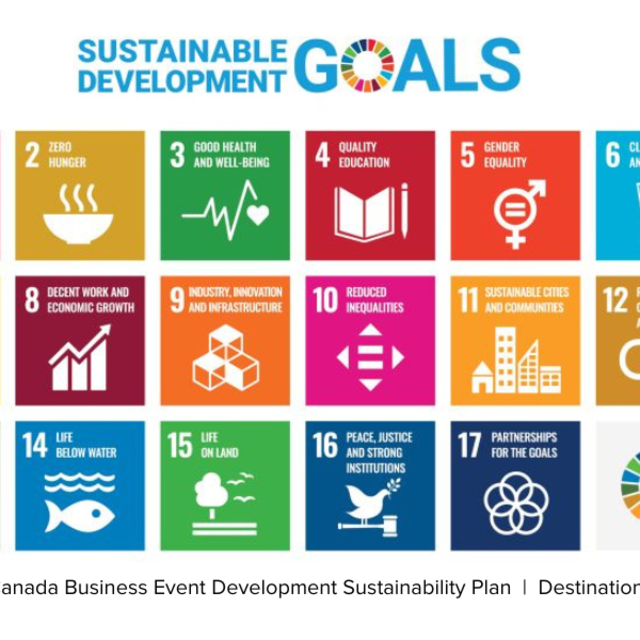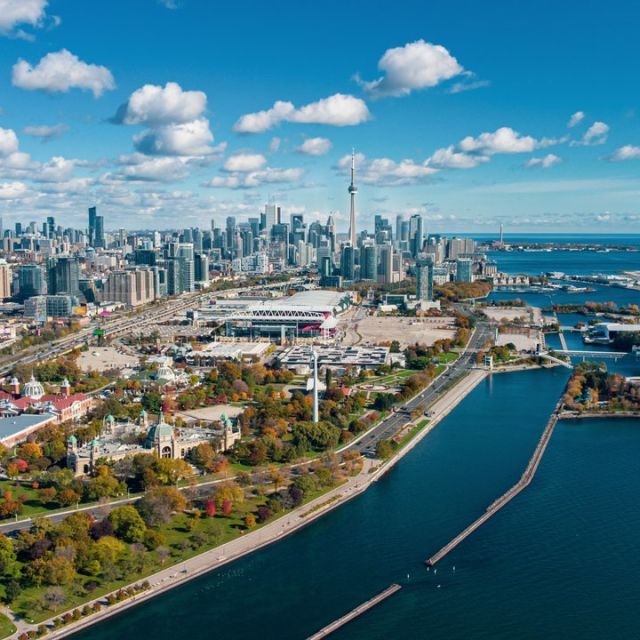When it comes to sustainability, the events and conference industry in Toronto continues to initiate, innovate and inspire.

Working toward greater sustainability within the events, meetings and conference industry is paramount, and Toronto is proud to be leading by example. Committing to solid sustainable practices involves taking stock of what we can do, making a viable to-do list and seeing it through. Here, three industry experts weigh in on what plans are taking shape.
“Toronto has amazing targets. Net-zero 10 years earlier than originally proposed is one of the most ambitious goals in North America—that’s pretty cool.”
– Virginie De Visscher, Executive Director, Business Events at Destination Canada
1. The Metro Toronto Convention Centre works toward sustainability in so many ways
“We try to incorporate sustainability into all the elements of our business—and we try to help everyone who holds an event in our building have the most sustainable event possible,” says Vivian Fleet, Vice President of Operations at the Metro Toronto Convention Centre (MTCC).
“There's been renewed interest in sustainability practices, which is fantastic,” Vivian says. “I think this has a lot to do with people wanting to differentiate themselves and to be responsible global citizens. There's a cost benefit to it, too—if you don't generate as much garbage, you don't have to pay for the disposal of it.” Every year, the facility redirects most event waste from landfill. In 2019/2020, almost one million kilograms of waste was diverted or recycled.
The building itself—part of Enwave Energy’s Deep Lake Water Cooling system—is a model of energy conservation. Other innovative practices at the MTCC include the upkeep of an apiary on the roof, a rooftop Chef’s Garden, textile recycling and the local procurement of food.
“Our donation program has also grown substantially over the past dozen years,” Vivian says. “Food is a huge part of that as well. There are a lot of people in the city—especially since the pandemic—who need our help and support.” The Centre’s charity partners include Second Harvest, Margaret’s Housing and Community Support Services, and the Toronto District School Board’s student nutrition program.
"A lot of clients are moving away from using aisle carpet and just opting for our polished concrete floor instead,” Vivian says. “This is a sustainability decision, because carpet is difficult to manage responsibly, and also has an economic benefit—no need to pay for its disposal at the end of the event. We also use an increasing amount of non-toxic products, which is not only good for the environment, but also good for our workers, making their jobs safer and healthier.”
2. The sustainability goals at Exhibition Place have been in place since 2004
“We tend to attract like-minded clients who are looking to host their events in a sustainable venue that also aligns with their corporate social responsibility as it relates to sustainability,” says Laura Purdy, General Manager at Exhibition Place.
“We have solar, wind and geothermal energy production right on our site. The wind turbine that we have was the first urban wind turbine in North America.”
– Laura Purdy, General Manager at Exhibition Place
With its award-winning LEED Platinum Enercare Centre and the LEED Silver Automotive Building (formerly known as Beanfield Centre), Exhibition Place spearheads environmental initiatives and cutting-edge green technologies across the board.

“We have solar, wind and geothermal energy production right on our site,” Laura says. “The wind turbine that we have was the first urban wind turbine in North America.” The turbine can generate one million kilowatt hours of electricity per year, an incredible example of energy self-sufficiency.
Exhibition Place’s GREENSmart environmental stewardship program includes a thermal energy distribution system that reduces the amount of energy needed to heat and cool its buildings. Energy-efficient systems are also in place to conserve lighting-related, including LED streetlights. The complex also works with clients to divert waste created during events by providing 4-stream recycling bins in all event spaces, which can accept paper, plastic and cans, compostable food waste and litter. Two green roof projects reduce HVAC costs, ultimately reducing greenhouse gas emissions. As well as an urban forestry program of 3,042 trees on its 152-acre site which further reduces pollution.
“We have signed the Net Zero Carbon Events Pledge to reduce our carbon down to net zero by 2050,” Laura says. “We’ve also signed the Sustainable Tourism 2030 Pledge, which will improve our sustainability performance between now and 2030. We’re very focused on achieving these goals, and I think we're well-positioned to achieve them ahead of the deadlines.”
3. The events and conference industry works together on a national level
“What really sets Canada apart is how we’re all in this together.” Virginie De Visscher, Executive Director, Business Events at Destination Canada, knows this first-hand. She led the Canadian Business Events Sustainability Plan, which launched in May 2022. The first of its kind, this national program aims to improve the economic, socio-cultural and environmental sustainability practices of business events hosted in Canada.
We worked with each participant’s different stakeholders—the airports, hotels, convention centres and other partners—to gather all the information: What is their environmental perspective for sustainability? Do they have a green plan? Do they have a mobility plan? What do they do in terms of social justice?”
– Virginie De Visscher, Executive Director, Business Events at Destination Canada
“What we have in Canada is our strength of collaboration,” Virginie says, outlining that 16 Canadian cities and regions are working together with a common goal to make events hosted in Canada—not just in one city — more sustainable. “Our clients are international associations and corporate clients, who are really looking for sustainable solutions for their events, and they need help.”

Currently, the destinations involved include Banff, Lake Louise, Calgary, Edmonton, Halifax, Kelowna, Montreal, Niagara Falls, Ottawa, Charlottetown, Quebec City, Saskatoon, St. John's, Toronto, Vancouver, Victoria and Winnipeg.
Phase 1 of the program laid down a basic framework of knowledge, providing participants with a good level of understanding so they could all speak confidently about sustainability. Phase 2 involved setting a baseline, using the Global Destination Sustainability Index. “The index is destination-based, is aligned with sustainable development goals and looks at the whole ecosystem, focusing on all three pillars of sustainability–environmental, sociocultural and economic,” Virginie says. “We worked with each participant’s different stakeholders–the airports, hotels, convention centres and other partners–to gather all the information: What is their environmental perspective for sustainability? Do they have a green plan? Do they have a mobility plan? What do they do in terms of social justice?”
Phase 3 is about telling the story and getting the message across, articulating how each destination provides sustainable solutions for their conference clients. “We’re giving our partners the tools they need to utilize all of the amazing things they’ve uncovered in order to create turn-key solutions for our clients,” Virginie says.

4. Toronto has the third-highest percentage of certified sustainable hotels in the world
This is good news from data provided by comparison firm Uswitch and Booking.com. Nearly one-quarter of the hotels in Toronto are certified sustainable, incorporating a variety of best practices into their operations. These include energy-efficient lighting, low-flow water systems, eco-friendly bathroom products and cleaning supplies, reducing plastic use, setting up filtered water stations in hallways and encouraging guests to reuse towels and linens. With regard to décor and furnishings, material options include more organic fabrics, unfinished and sustainable wood, reclaimed materials, and recycled metal and plastic.
Nearly one-quarter of the hotels in Toronto are certified sustainable, incorporating a variety of best practices into their operations.
1 Hotel Toronto, for example, diverts more than 85% of its waste from landfills, due to an on-site composter. LEED Silver-certified Hotel X Toronto employs a very high-performance building system, using on-site renewable energy and an irrigation system for collecting rainwater.
5. The City of Toronto helps support greener meetings and conferences
The Toronto City Council has an ambitious plan to help reduce greenhouse gas emission in the city to zero by 2040—no small feat. To reach this target, quite a few changes are on the agenda to regulate, advocate and facilitate sustainability transformation.
Plans are being made to determine a carbon budget for the city’s own operation and for the community as a whole. Steps to reducing the use of natural gas and establishing goals for existing buildings are also afoot. The city plans to ramp up biking, public transit and electric vehicles, while also encouraging walking and biking. Local, renewable energy will also increase to create a more carbon-free grid.
“Toronto has amazing targets,” Virginie says. “Net-zero 10 years earlier than originally proposed is one of the most ambitious goals in North America—that’s pretty cool. Toronto also has the largest fleet of electric buses in North America. Just the sheet size of the city allows it to have so many options available when you begin to formulate an event plan.”
6. Toronto’s small food and beverage businesses play a big part in sustainability
Many local restaurants, food suppliers and caterers are setting stellar examples by making sustainability an integral part of their business model.
There are a myriad of examples. Pluck Tea prevents waste by using upcycled food—ingredients that are procured via verifiable supply chains and would not have been consumed otherwise. Caterer Daniel et Daniel is a leader in the industry for composting and recycling, its environmental policy listing things like GMO-free ingredients, food waste composting, biodegradable cutlery and cups, and bamboo dishes. Bee Local 416 apiarists have honeybee hives in backyards and rooftops all over Toronto, cared for by registered beekeepers using sustainable, organic methods. This is merely scratching the surface.
The food and beverage teams of both MTCC and Exhibition Place pride themselves on partnering with local distributors and farmers for their catering menus, much of their craft beer and wine lists are Ontario-based.
“When you incorporate sustainability into all aspects of your business, it is good for the people and good for the environment—and it can make good business sense,” Vivian says.
Building on the foundation of sustainable practices is the key to working toward your goals, achieving them and then setting new ones, inspiring others in the process. “It’s not one thing that’s going to get us there,” Laura says. “We have to look at what we can achieve individually and together.”
“Sustainability is a journey,” Virginie adds, “and we need to look forward.”



